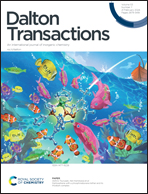[Ag4Br6] cluster-based 3D bromoargentate hybrid: crystal structure, optical/photoelectrical performance and theoretical study†
Abstract
The self-assembly of cluster-based halide framework materials has been a matter of great interest but with great challenges. Herein, by exploiting hexamethylenetetramine (Hmta) with Td symmetry as a structural modifier, we successfully constructed and systematically characterized an unusual three-dimensional (3D) hybrid bromoargentate, namely K[NH4][Ag4Br6(Hmta)] (1), bearing a diamond-type [Ag4Br6(Hmta)]n2n− anionic skeleton built up from adamantane-like units of inorganic [Ag4Br6] clusters and organic Hmta ligands. UV–Vis diffuse reflectance analysis showed that the optical bandgap of the title compound was 2.68 eV, indicating a visible-light-responsive semiconductive behavior. More importantly, upon alternate light illumination, the so-designed compound exhibited remarkable photoelectric switching properties, with photocurrent densities (0.38 and 1.10 μA cm−2 for visible and full-spectrum light, respectively) that compete well with and even exceed those of some high-performance metal halide counterparts. Further theoretical calculations, including band structure, density of states, and wave functions, revealed that compound 1 has a unique valence band and conduction band distribution, rendering it with small effective masses (especially the electrons), which may be responsible for its good photoelectricity. Furthermore, in this work, Hirshfeld surface analysis, thermogravimetric analysis, and X-ray photoelectron spectroscopy (XPS) studies were performed.
![Graphical abstract: [Ag4Br6] cluster-based 3D bromoargentate hybrid: crystal structure, optical/photoelectrical performance and theoretical study](/en/Image/Get?imageInfo.ImageType=GA&imageInfo.ImageIdentifier.ManuscriptID=D3DT03264G&imageInfo.ImageIdentifier.Year=2024)


 Please wait while we load your content...
Please wait while we load your content...